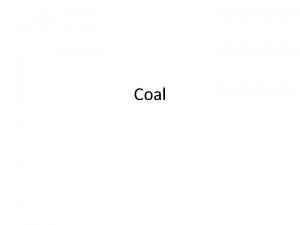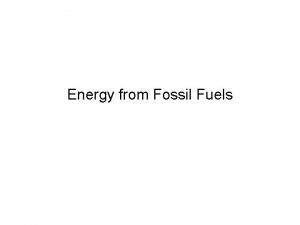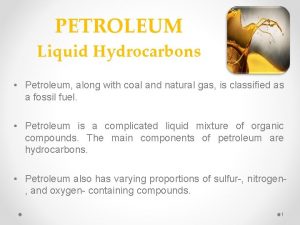Liquid Coal Producing Liquid Fuel from Non Petroleum







- Slides: 7

Liquid Coal: Producing Liquid Fuel from Non. Petroleum Sources by Joshua D Hartman, Kelly Theel, and Jack F. Eichler Department of Chemistry University of California-Riverside

The New York Times Monday, August 6, 2012 May 25, 2011, 4: 53 pm Bill Allows Military to Use High-Carbon ‘Liquid Coal’ By JOHN COLLINS RUDOLF http: //www. nytimes. com/ 2

An amendment to a major military spending bill before the House would rescind a 2007 federal law barring the Defense Department from using alternative fuels, like synthetic oil made from coal, that produce more climate-altering pollution than conventional fuels. A bill containing the amendment cleared the House Armed Services Committee this month. The military’s annual consumption of about 120 million barrels of oil is not only an enormous cost to the federal government but also a strategic risk because of the volatility of world oil markets, military analysts have said. The Defense Department has a goal of obtaining 25 percent of its energy from renewable sources by 2025. As a result of the 2007 law, written by Democrats, a significant part of that effort is now focused on developing advanced biofuels like those made from algae with reduced carbon footprints. But the focus on biofuels has been criticized by Republicans, who argue that the strategic imperative of reducing dependence on foreign oil outweighs the need to reduce the military’s carbon dioxide emissions. Were the provision barring high-carbon fuels eliminated, the Defense Department could renew its development of synthetic oil made from coal — a process developed by the German military during World War II when its access to oil reserves was blocked. The carbon dioxide emissions associated with coal-to-liquid fuel are roughly double those from conventional oil… … “At a time when American forces are combating terrorists abroad, it is especially necessary for the Pentagon to have the versatility to secure and develop alternative sources of fuel from a friendly ally, ” Marty Durbin, vice president of the American Petroleum Institute, a lobbying group, said in a statement this month. 3

Analysis 1. What are the potential issues and major topics in this scenario that we as chemists/scientists can address? 4

Analysis 2. Compile a list for each category: What do I know? What do I need to know? 3. Rank the importance of the questions in the “What do I need to know” column. 5

Coal and Biomass to Liquid Fuel H 2 + CO (unreacted) O 2 H 2 CO 2 + H 2 O 6

Slide Credits Slide 1: Licensed image © Mrreporter | Dreamstime. com, file ID #12622928. Slide 2 and 3: http: //green. blogs. nytimes. com/2011/05/25/bill-allows-military-to-use-high-carbonliquid-coal/ Slide 6: http: //www. clker. com/clipart-gas-pump 2. html 7













